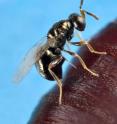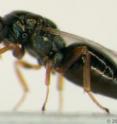Genome sequences for wasps will aid pest and disease control, provide new model organism
Related images
(click to enlarge)
Scientists have mapped the genomes for three kinds of parasitic wasps, providing a new genetic model system based on the Nasonia genus. The availability of these genome sequences will aid the analysis of complex genetic traits, such as skin color, as well as complex human diseases. Published in the Jan. 15 issue of Science, the findings may help advance our understanding of how to use these wasps as natural agents against agricultural pests and disease-carrying insects. "These genome sequences will be a major tool for agricultural pest control," said Chris Smith, assistant professor of biology at San Francisco State University and one of the study's authors. "Many people may not realize how dependent humans are on these tiny wasps which protect our food crops and save the U.S. billions of dollars each year by reducing crop loss."
An international consortium of scientists mapped the complete DNA sequences for three species in the Nasonia genus, a group of tiny parasitic wasps that are a quarter of the size of a fruit fly. The wasps lay their eggs on other insects, which then hatch and kill the host creature. Wasps in the Nasonia genus are particularly suited to genetic research because the males develop from unfertilized eggs. Since they only have one copy of each gene, scientists can immediately see the effects of mutant genes, while in most species the second copy of the gene can hide problems in a mutant gene.
Source: San Francisco State University
Articles on the same topic
- Parasitic wasps' newly sequenced genomes reveal new avenues for pest controlFri, 15 Jan 2010, 15:26:18 UTC
- Genome advances peril for pestsThu, 14 Jan 2010, 22:25:50 UTC
- Genome of parasitic wasps releasedThu, 14 Jan 2010, 19:38:00 UTC
- Parasitic wasps' genomes provides new insights into pest control, geneticsThu, 14 Jan 2010, 19:27:48 UTC
- Sequencing wasp genome sheds new light on sexual parasiteThu, 14 Jan 2010, 19:27:43 UTC
Other sources
- Wasp genome could aid pest controlfrom UPIMon, 18 Jan 2010, 22:21:30 UTC
- Wasp genome holds targetsfrom Science AlertSun, 17 Jan 2010, 12:56:10 UTC
- Sequencing wasp genome sheds new light on sexual parasitefrom Science DailySat, 16 Jan 2010, 1:14:18 UTC
- Swarms of Engineered Voodoo Wasps Will Seek and Destroy Crop Pestsfrom PopSciFri, 15 Jan 2010, 16:42:14 UTC
- Genome advances peril for pestsfrom Science BlogFri, 15 Jan 2010, 3:42:09 UTC
- Genome advances peril for pestsfrom Science BlogThu, 14 Jan 2010, 23:35:19 UTC
- Genome of parasitic wasps releasedfrom Biology News NetThu, 14 Jan 2010, 23:21:16 UTC
- Parasitic wasps' genomes provides new insights into pest control, geneticsfrom Science DailyThu, 14 Jan 2010, 22:28:05 UTC
- Sequencing Wasp Genome Sheds New Light on Common Sexual Parasitefrom Newswise - ScinewsThu, 14 Jan 2010, 19:35:13 UTC
- Parasitic wasps' genomes provides new insights into pest control, genetics (w/ Video)from PhysorgThu, 14 Jan 2010, 19:14:35 UTC
- Scientists decode genome of helpful waspsfrom CBC: Technology & ScienceThu, 14 Jan 2010, 19:14:20 UTC

